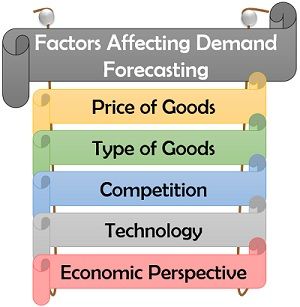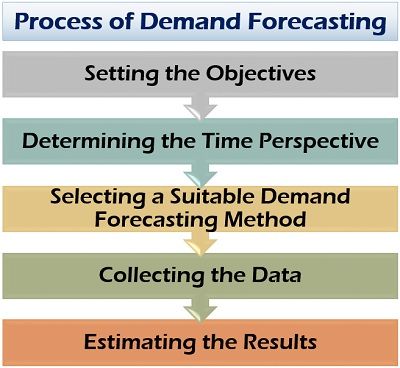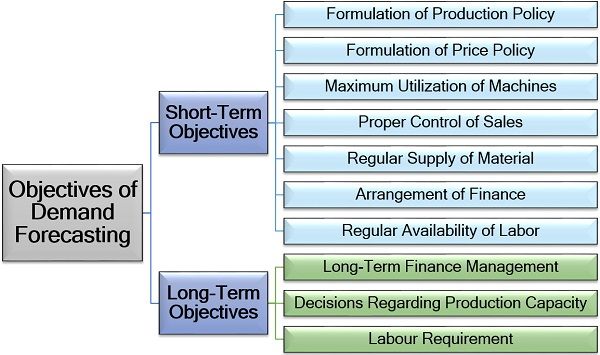Definition: Demand forecasting refers to a scientific and creative approach for anticipating the demand of a particular commodity in the market based on past behaviour, experience, data and pattern of related events. It is not based on mere guessing or prediction but is backed up by evidence and past trends.
Example: A printing press owner forecasts high demand for notebooks in June and July due to the new session. Therefore, he plans for a large-scale production during this time and arranges for the raw material, workforce, finance and machinery accordingly.
Content: Demand Forecasting
Factors Affecting Demand Forecasting
Demand is never constant and fluctuates with the change in certain factors related to the commodity and the market in which the business operates. With the changing demand, it’s forecasting also varies.
Following are some of the factors which influence the demand forecasting of a commodity:
- Price of Goods: Demand estimation is highly dependant on the price of goods or services. The pricing policy and fluctuation in the present price can give an idea of change in demand for that particular commodity.
- Type of Goods: The kind of commodity, its features and usability determines the customer base it is going to cater. The demand for existing goods can be easily estimated by following the previous sales trend, competitors’ analysis and substitutes available. Whereas, the demand for a new product on the market is difficult to predict.
- Competition: The level of competition in the market supports the process of demand forecasting. It is easy to predict sales in a less competitive market, whereas the same becomes difficult in a market where the new firms can freely enter.
- Technology: The demand for any product or service changes drastically with the advancement in technology. Therefore, it is essential for an organisation to be aware of technological development while forecasting the demand for any commodity.
- Economic Perspective: Being updated with economic changes and growth is necessary for demand forecasting. It assists the organisation in preparing for future possibilities and analysing the impact of economic development on sales.
Process of Demand Forecasting
Demand forecasting is not based on assumptions but is a systematic and scientific process of estimating future sales and performance as well as directing the resources accordingly.
The steps involved in a standard demand forecasting process are as follows:
Setting the Objectives: The purpose for which the demand forecasting is being done must be clear. Whether it is for short-term or long-term, the market share of the product, the market share of the organisation, competitors share, etc. By all these aspects, the objectives for forecasting are framed.
Determining the Time Perspective: The defined objectives are supported by the period for which the forecasting is being done. The demand for a commodity varies with the change in its determinants over the period.
There is a negligible change in price, income or other factors in the short run. But, the organisation may notice a considerable difference in these determinants over a long-term, affecting the demand of a commodity.
Selecting a Suitable Demand Forecasting Method: Demand forecasting is based on specific evidence and is determined using a particular technique or method. The method of prediction must be selected wisely. It is dependant on the information available, the purpose of predicting and the period it is done for.
Collecting the Data: Forecasting is based on past experiences and data. This data or information can be primary or secondary. Primary data comprises of the information directly collected by the analysts and researchers; whereas secondary data includes the physical evidence of the past performance, sales trend in the past years, financial reports, etc.
Estimating the Results: The data so collected is arranged in a systematic and meaningful manner. The past performance of a product in the market is analysed on this basis. Accordingly, future sales prediction and demand estimation are done. The results soo drew must be in a format which is easy to understand and apply by the management.
Objectives of Demand Forecasting
Demand forecasting is one of the significant components in the success of any business. All organisational activities, whether they are short-term business operations or long-term strategic decisions, are dependant on it.
These objectives are illustrated under the following categories further sub-divided into points:
Short-Term Objectives: To ensure the effective working of the organisation, estimation of sales for the past six months is done. Let us now go through the following purpose of demand forecasting in the short run:
- Formulation of Production Policy: Demand forecasting aims at meeting the demand by ensuring uninterrupted production and supply of goods and services.
- Formulation of Price Policy: It helps in formulating an effective price mechanism to deal with the market fluctuations and conditions like inflation.
- Maximum Utilization of Machines: It streamlines the production process and operations such that there is the optimum utilisation of machines.
- Proper Control of Sales: Forecasting the regional sales of a particular product or service provides a base for setting a sales target and evaluating the performance.
- Regular Supply of Material: Sales forecast determines the level of production, leading to the estimation of raw material. Thus, a continuous supply of raw material and inventory management can be done.
- Arrangement of Finance: To maintain short-term cash in the organisation it is essential to forecast the sales as well as liquidity requirement accordingly.
- Regular Availability of Labor: Estimation of the production capacity provides for the acquisition of suitable skilled and unskilled labour.
Long-Term Objectives: Demand forecasting is inevitable for the long-term existence of an organisation. Following objectives justify the statement:
- Long-Term Finance Management: Forecasting sales for the long-term contributes to long-term financial planning and acquisition of funds at reasonable rates and suitable terms and conditions.
- Decisions Regarding Production Capacity: Demand forecast determines the production level, which provides a base for decisions related to the expansion of the production unit or size of the plant.
- Labour Requirement: Demand forecasting initiates the expansion of business, thus leading to the estimation of required human resource to accomplish business goals and objectives.
Estimating demand with accuracy requires a lot of expertise and knowledge. Therefore experts are hired by the business organizations to ensure better results and proper utilization of resources.
Leave a Reply